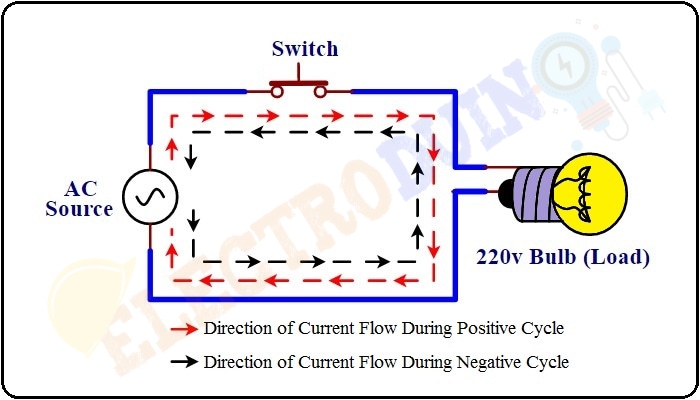Electric Current
Subject: Science

Overview
Direct current (d.c.) is a current flowing in a specific direction, such as in batteries, dry cells, or solar panels. Alternating current (a.c.) is a continuous current with varying amplitude and polarity over time, such as in dynamos and generators. The current magnitude remains constant at 4A, while the alternating current's magnitude grows from 0 to 5A before falling back to zero. Both a.c. and d.c. power various electrical appliances and can be converted using a rectifier.
Direct Current and Alternating Current
A dry cell's two poles are seen in the illustration. Additionally, it demonstrates the direction in which the conducting wire's electric charges are moving. When the cell is linked to the electric circuit and the light is switched on, figure from the cell's negative terminal to its positive terminal. Comparably, the other figure illustrates how current flows via a conducting wire in a certain direction when a solar panel's electric current lights a lamp. Thus, the term "direct current" (d.c.) refers to a current that flows in a certain direction.The sources of D.C. include batteries, dry cells, and photocells (solar panels).

The figure depicts a light that emits light when using dynamo power. The positive and negative terminals are not separated in the image above, unlike in the dry cell and solar panel. A simplified representation of the direction of the current produced as the magnet is rotated between the dynamo's coils may be found in Figure.
The blue arrow in the same picture indicates that the charge on the conducting wire is moving forward, and the red arrow indicates that the same charge is flowing in the opposite direction after a short period of time. This kind of current has a direction shift every predetermined amount of time. Likewise, the current's magnitude progressively rises from its lowest to its highest value. Therefore, alternating current (a.c.) is defined as a current whose amplitude and polarity alternate continuously over a predetermined period of time. Sources of a.c. include dynamos, a.c. generators, etc.
Current Time Graph
A time current graph, like the one in the figure, illustrates how the direct current's current magnitude stays constant with respect to time. In a similar manner, the figure illustrates how the alternating current's size and direction can vary over time.
The direct current time graph demonstrates that despite the duration being longer, the current's magnitude remains constant at 4A. Comparably, the alternating current's current time graph displays that the current's magnitude grows from 0 to 5A before falling back to zero. Following that, the current value rises once more, but in the exact opposite direction (i.e., to -5A), before falling to zero once more.A cycle has consequently ended. Frequency, in the context of a.c., is the quantity of cycles finished in a single second. The frequency of an alternating current is one hertz (1 Hz) if a single cycle takes one second to complete. Our nation uses 50 Hz for its a.c. frequency, with an average voltage between 220 and 240 volts. This indicates that 100 times each second, the orientation of the a.c. utilized in our nation changes. The frequency of d.c. current is zero since its direction remains constant throughout time.
Different electrical appliances that we use on a daily basis run on different voltages, some on a.c., some on d.c., and others on both a.c. and d.c. Fans, motors, freezers, and other electrical appliances work on a.c. power, but internal circuits of computers, mobile phones, and other electrical appliances utilize d.c. Both alternating current and direct current can run electric heaters, filament lights, etc.Alternating current may be changed into direct current with the use of a rectifier.
Things to remember
- Direct current refers to a current flowing in a specific direction.
- Alternating current is defined as a current whose amplitude and polarity alternate continuously over a predetermined period.
- The current time graph shows how the magnitude of the direct current stays constant over time.
- Different electrical appliances run on different voltages, some on AC and some on DC.
© 2021 Saralmind. All Rights Reserved.



 Login with google
Login with google